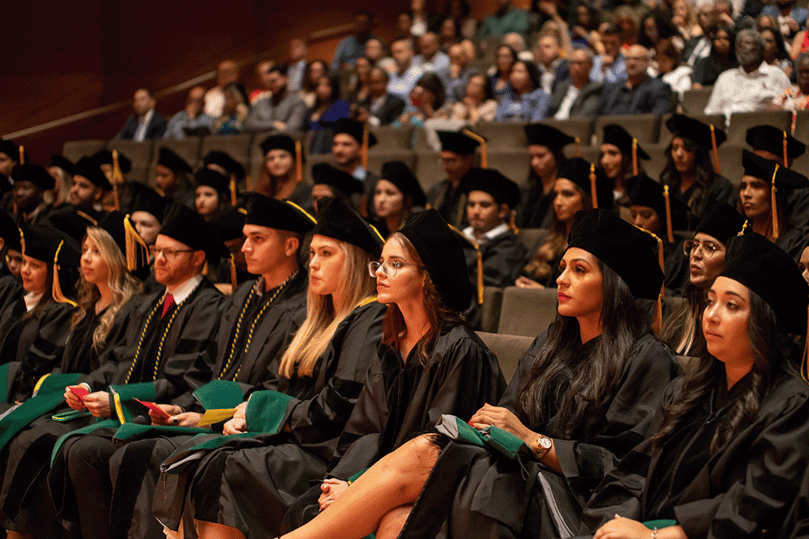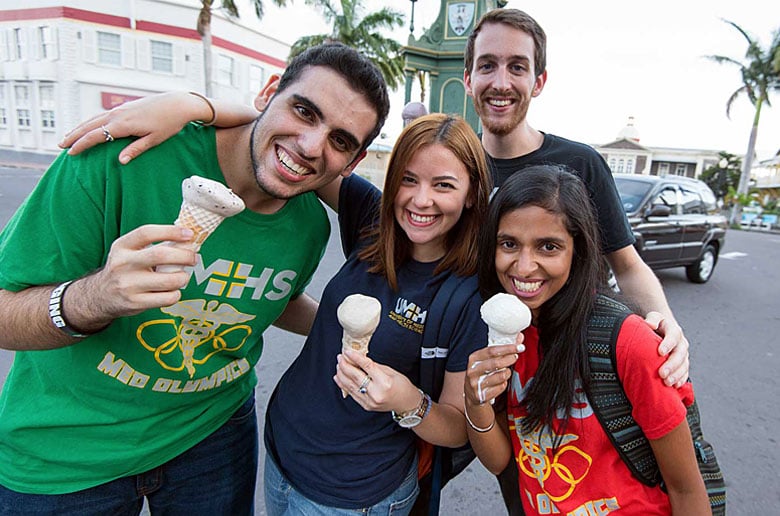Latest News
Admission
Financial Aid
The Campus Experience
Matching for residency is a critical step on the path to becoming a practicing physician. UMHS students qualify to apply for residency in the U.S., Canada, and Puerto Rico, and our students have an exceptional track record for earning premier placements in top hospitals. Read on for details about the residency matching process.
Our students first participated in the NRMP (National Resident Matching Program, or “The Match”) in March 2011 and in CaRMS (the Canadian Resident Matching Service) in 2012. Each year since, our graduates have placed into a variety of competitive specialties and hospital programs throughout the United States and Canada.
Read moreThe National Resident Matching Program (NRMP) is a national placement service in which the majority of United States residency programs and residency-seeking medical students participate. Applying through the NRMP greatly optimizes a medical student’s chances of obtaining a residency position. The vast majority of UMHS students who obtained residency did so through “The Match.”
To participate, students must first apply to programs through the Electronic Residency Application Service (ERAS) over the summer. Then, in September, they must enroll in the NRMP in order to match with a participating residency program. Students typically begin their ERAS applications in the June prior to their intended match year in preparation for early September submissions.
In order to participate in the Match process, students must have successfully passed USMLE Step 1 and Step 2 CK as well as completed a significant portion of the clinical program. In addition to the USMLE requirements, students must also satisfy either Pathway 3 or 6, which were established as an alternative to Step 2 CS by ECFMG in 2021. After applying to the NRMP, students must apply to each residency program in which they are interested and participate in interviews. ECFMG Pathways was developed to meet the Communication and Clinical Skills Assessment (CS) requirement for ECFMG Certification. Pathways consists of the Pathways Application, the Communication assessment through the Occupational English Test (OET), and the Clinical Skills Attestation certified through the UMHS Registrar’s Office. UMHS students must obtain Pathway 3 Approval, unless they have previously failed the USMLE Step 2 CS or if they must revalidate their expired Pathway 3 Approval. Then they must obtain Pathway 6 Approval.
Typically, students enroll with ERAS during the summer and spend several weeks populating applications. They go on to submit their applications to programs in September and await interview invitations. Students may enroll in the NRMP in September as well.
In late February, after a four-month interviewing season, both students and programs submit their respective “rank order lists” to the NRMP. Students list programs where they interviewed, ranked from most to least desirable, while residency programs submit their rank order lists, applying similar consideration.
Following a computerized matching process that takes place between February and mid-March, results are released the third week of March. Since students match to programs with binding contracts, it illuminates the importance of ranking from “most desirable to least.” Traditionally, these residency appointments begin on July 1.
If a student fails to match, they are subsequently eligible for the SOAP (Supplemental Offer and Acceptance Program), which is thought of as a secondary match, or “mini-Match.” Participants can alternatively seek a program “outside the match” through both the NRMP’s list of unfilled programs and by finding vacancies that become available throughout the early spring and summer.

UMHS students from Canada have the option to apply to both the NRMP and their own national match, CaRMS (Canadian Resident Matching Service, or the “Canadian Match.”)
Similarities exist between the Canadian matching process and the NRMP, with different key components. CaRMS begins a little later in the summer, the interview season is shorter, results come out sooner, and programs expect applicants to include results from their National Board exams, specifically the NAC (National Assessment Collaboration) and MCCQE1 (Medical Council of Canada Qualifying Exam Step 1), issued by the Medical Council of Canada. The difference in their calendar allows for dual participation in the NRMP, should a given student not first match in Canada.
Both U.S. citizens and Canadian students seeking U.S. residency must pass the USMLE Step 1 and USMLE Step 2 CK go through ECFMG Pathways 3 or 6, successfully complete the Basic and Clinical Science Program and present their diploma and certification from the Educational Commission for Foreign Medical Graduates (ECFMG) to their program.
A certificate from ECFMG validates that a foreign medical school and its students have achieved comparable standards to U.S. medical schools, and that their school meets the standard expected from United States residency programs.
Canadian students matching in Canada must also meet all university requirements, including U.S. exams, in addition to completing at least the NAC and MCCQE1 for baseline consideration. Students must also present a diploma to their Canadian residency before beginning it, also in or around July 1.


UMHS students have an impressive track record of attaining top residencies in the U.S. and Canada. See where they’ve matched.
Read more